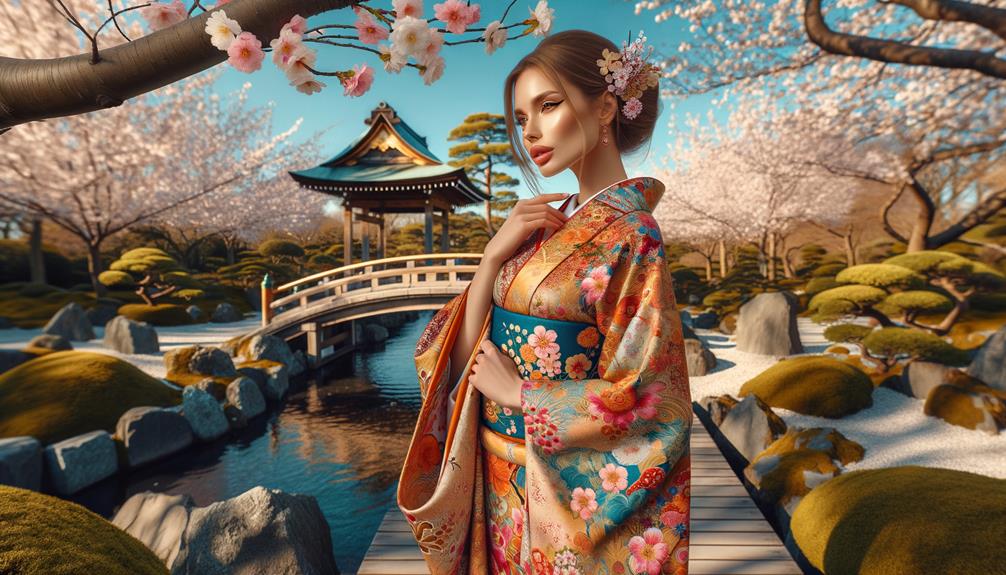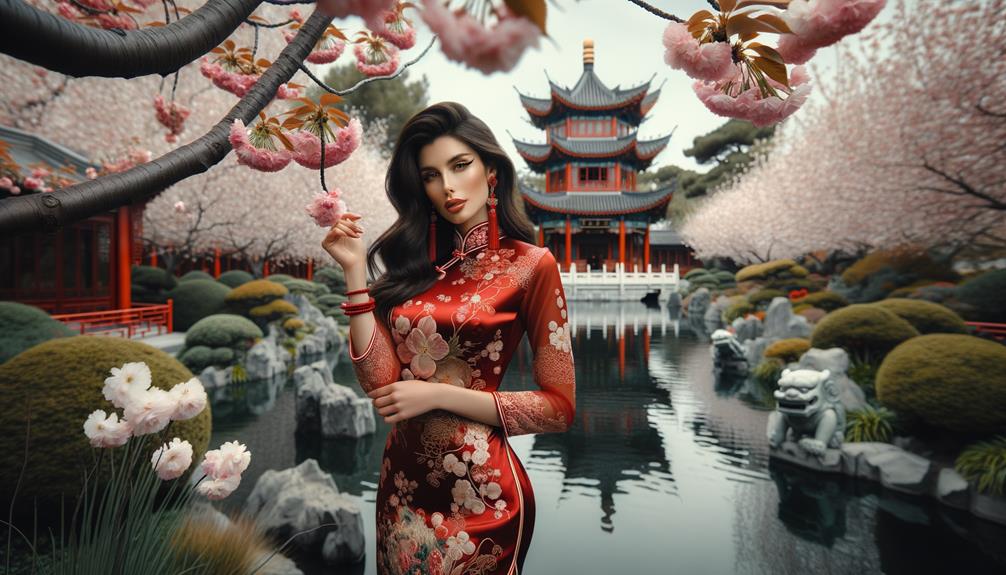Many overlook Agbada robes' Islamic roots despite their association with West African royalty and ceremonies. This cultural fusion birthed a garment embodying evolution and identity. The intricate patterns and beadwork don't merely decorate; they hold symbolic meaning and history. Each robe narrates a distinct tale, interwoven with tradition and personal expression. Clothing can encapsulate so much, inviting exploration into its origins and significance—a fascinating concept.
History and Origins
Agbada's journey originates from the 7th century Islamic conquest of North Africa, evolving into a status symbol by the 12th century. This cultural transformation captivates me. Observing Berber and Arab merchants trading salt and cloth for gold and slaves in West Africa, I see how they introduced the Agbada to the region.
Museum exhibits reveal how the Agbada took root among the Yorubas, thanks to the Peuls or Fulanis. This Islamic garment adapted into something distinctly West African. The fabric, often Aso Oke, narrates its own stories through intricate embroidery and vibrant colors.
Contemplating this fusion of cultural and religious influences, I consider the countless hands that have sewn these robes, each stitch paying tribute to a rich heritage. The Agbada transcends mere clothing; it symbolizes transformation and adaptation.
Amidst modern society's bustle, it stands as a reminder of our interconnected past. As we innovate and push boundaries, the Agbada remains a timeless piece, bridging ancient traditions with contemporary style. The journey, preserved in museum collections, continues to inspire awe.
Cultural Significance
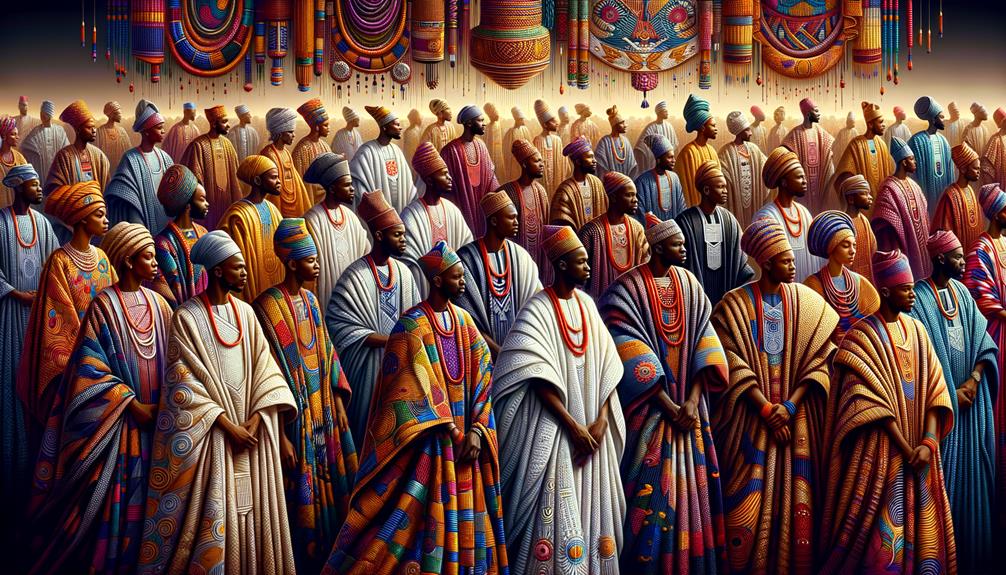
The Agbada, adorned with vibrant threads and rich hues, epitomizes West Africa's cultural mosaic. More than just attire, this ceremonial robe speaks volumes about identity, heritage, and craftsmanship. Each embroidered stitch narrates a tale rooted in Yoruba tradition and Islamic influences. Beholding an Agbada evokes a canvas interweaving the old and modern.
Institutions like the Metropolitan Museum and the Museum of Art showcase Agbada robes as more than mere exhibits. These garments symbolize African fashion's global resonance and deep-rooted history. Once reserved for special occasions, Agbadas now resonate with younger generations seamlessly blending customs with contemporary styles.
| Museum | Significance |
|---|---|
| Metropolitan Museum | Spotlights Agbada robes' worldwide impact and profound historical context. |
| Museum of Art | Celebrates the artistry and cultural narratives intricately woven into each ceremonial robe. |
Reflecting on the Agbada's journey underscores its dynamic role in African culture. These robes bridge generational gaps, uniting tradition with modern aesthetics. The Agbada transcends clothing; it's a statement, a celebration, a legacy.
Design and Fabric
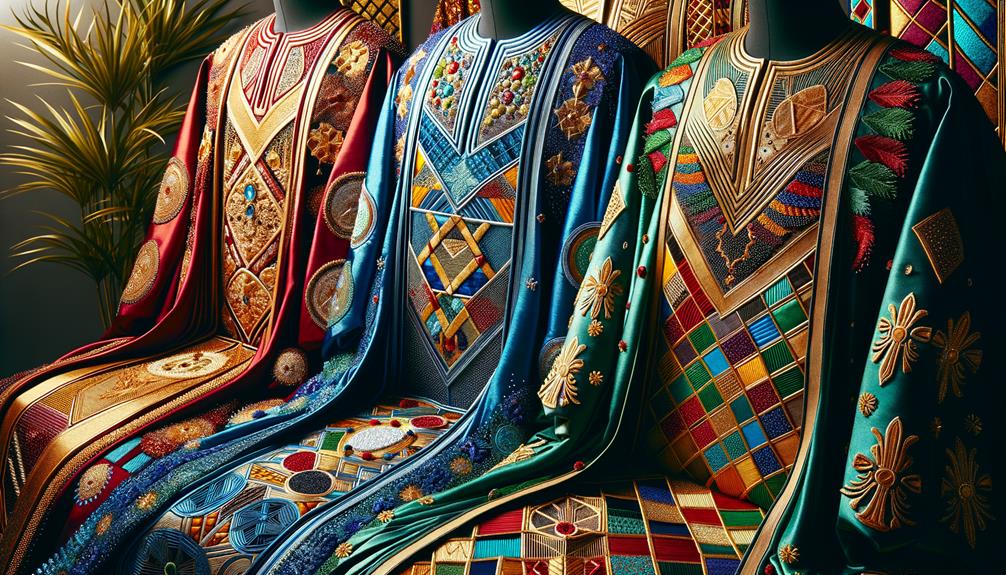
The rich embroidery and ornate fabrics of Agbada robes captivate at first glance. Each intricate pattern and material choice narrates stories of heritage and prestige. The elaborate detailing showcases the immense artisanship poured into every garment.
Traditional Patterns and Symbols
Intricate embroidered patterns on traditional Agbada robes narrate stories of power, spirituality, and cultural heritage. Each stitch intertwines a tale – geometric shapes and symbols speaking their own language. Circles, animals, and abstract forms aren't just decorative; they're messages deeply rooted in Yoruba culture.
These symbols breathe life into fabric, transforming it into a canvas of history and identity. The colors, too, hold meaning. Green threads symbolize spirituality; yellow ones represent divination practices. It's an interplay of design and significance, where every choice matters.
Consider the beadwork often adorning Agbada robes. It's visually stunning yet intentional. Those beads aren't random; they add layers of tradition and aesthetics. They pay homage to heritage, reminding us of the skill behind each garment.
For those seeking innovation, these traditional patterns offer a rich tapestry. They aren't just relics but inspiration for the future. Modern design can borrow from this well, blending old and new, crafting garments that resonate with both history and contemporary style.
Material Choices and Textures
The rich velvet and silky fabrics of Agbada robes don't merely showcase wealth but wrap the wearer in a luxurious tactile experience, celebrating cultural heritage and traditions. Running my fingers across the smooth velvet, I'm instantly connected to the fibers woven with generations of artistry. Silk's sleek texture exudes elegance and sophistication.
These robes transcend mere clothing; they are symbolic statements. Velvet and silk are reserved for momentous occasions like weddings, ceremonies, and significant gatherings, adding an undeniable aura of luxury. Even cotton's inclusion is thoughtful, chosen for quality and lasting wear.
The fabric's texture transforms the entire ensemble. Lavish materials like velvet elevate the visual appeal, making each robe a masterpiece. Donning an Agbada, the fabric's weight and feel remind me of its deep cultural resonance.
These material choices and textures connect us to tradition in a tangible, contemporary way, marrying the past with the present through innovative design.
Embellishments and Detailing
With each painstaking stitch and carefully placed bead, Agbada robes reveal the immense artistry and cultural richness behind their creation. The intricate embroidery, often geometric and symbolic in nature, showcases the skilled craftsmanship woven into these garments. Crafted from luxurious fabrics like velvet, silk, and cotton, each robe exudes a regal allure that demands attention.
The embellishments adorning these robes are a testament to their opulence:
- Glass beads glimmer and reflect light, adding a touch of sparkle to the designs.
- Sequins bring a festive shimmer, perfect for celebratory occasions.
- Metallic threads offer a subtle glow, making the intricate patterns stand out.
The level of detailing varies depending on the occasion. For formal events, the designs are lavish, the patterns complex, demanding the viewer's undivided attention. Everyday wear, while still elegant, embraces a simpler aesthetic, paying homage to tradition without overwhelming the senses.
These robes are a true reflection of the innovation that goes into preserving cultural heritage through fabric. The balance of luxury and history woven into each piece is truly striking. The craftsmanship embedded in every detail speaks volumes about the rich cultural tapestry of West Africa. It's a harmonious blend of art and function, intricately woven into the very fabric of the region's identity.
Agbada robes are more than mere garments; they adorn the spirit, with every embellishment serving as a tribute to the ancestral artisans who paved the way for this timeless tradition.
Embroidery and Patterns
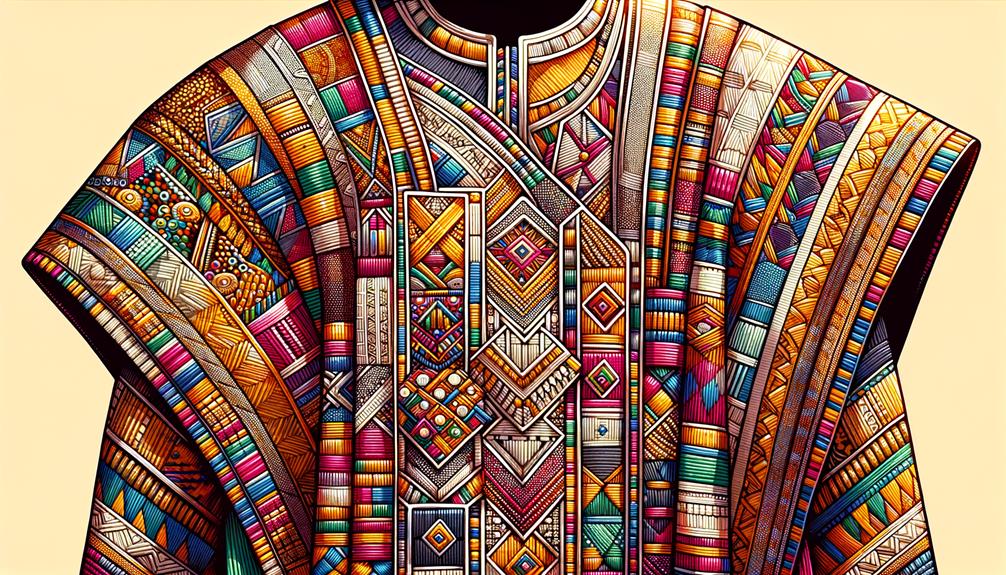
Embroidery on Agbada robes offers insight into the wearer's cultural background and societal status. Intricate patterns and symbolic designs communicate more than mere decoration; they form a visual narrative. Whether painstakingly hand-stitched or machine-made, each stitch demonstrates craftsmanship that shares a story. These designs showcase regional distinctions, reflecting diverse cultural influences and personal preferences.
I observe how these patterns convey messages, proverbs, and social positioning. The artistry woven into each robe is profound, a silent dialogue between the individual and the observer. The detailed embroidery transcends mere adornment; it's a tapestry of history and tradition. One region might showcase bold, geometric patterns, while another features delicate, symbolic motifs.
The embroidery's richness isn't limited to the complexity of the designs but encompasses the cultural significance they embody. Each thread intertwines pieces of West Africa's vast, diverse heritage. I reflect on this amalgamation of artistry and meaning, appreciating how it transforms a simple garment into a powerful expression of identity and legacy. While the patterns evolve, they remain rooted in tradition.
Modern Adaptations
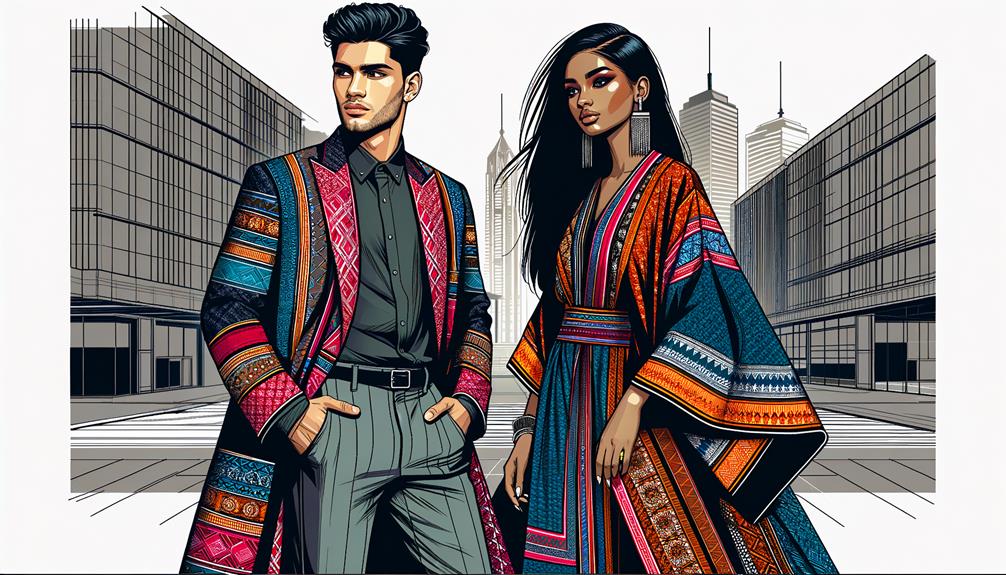
Agbada robes receive a contemporary makeover as designers infuse traditional elements with modern aesthetics. These garments now transcend cultural boundaries, appealing to diverse audiences through their versatility and personalization.
Fabric choices range from luxurious silks to breathable cotton, redefining the robe's feel and function. Vibrant colors replace traditional earthy tones, adding a fresh twist. Intricate patterns adorn the robes, transforming them into statement pieces.
This fusion of past and present isn't merely a fashion statement; it's a cultural dialogue, an expression of identity resonating globally. Social media amplifies these adaptations, showcasing the creativity inherent in each design. Across generations, the evolution of Agbada ensures this iconic robe remains relevant and celebrated.
Wearing Agbada
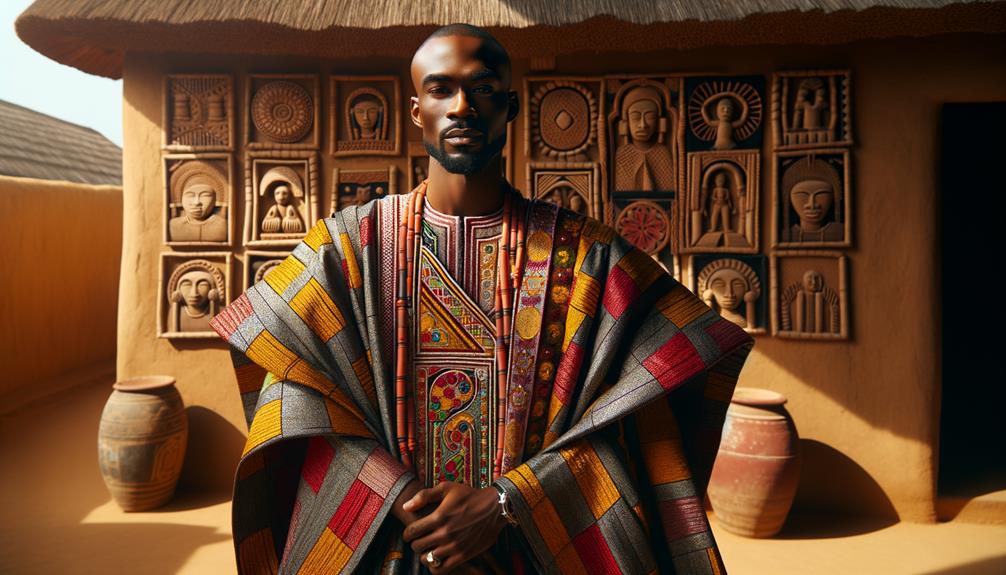
Slipping into an Agbada instantly transports you to a realm steeped in heritage and tradition. The wide sleeves and matching fila hat and trousers drape you in layers rich with cultural significance. Fine fabrics like cotton, silk, or velvet whisper tales of ancestry and social standing.
The intricate embroidery and beadwork become canvases showcasing artistry and meaning. Each stitch blends skill with symbolism, an outward display of one's roots and personal flair. This isn't mere clothing; it's a statement of identity and prestige. Donning an Agbada carries a profound weight.
These garments shine during special occasions and ceremonies integral to the Yoruba people. They exude respect and honor, providing a visual representation of wealth and customs intertwined. Designs vary by region, event, and individual taste, rendering each piece a genuine masterwork.
Wearing Agbada bridges past and future, upholding continuity while leaving room for innovation. Each time it's worn, connections deepen with a storied cultural tapestry, simultaneously honoring heritage and embracing evolution. A seamless blend of tradition and modernity.
Frequently Asked Questions
What Do Agbada Robes Represent?
Agbada robes symbolize cultural identity and heritage, embodying intricate craftsmanship and pride. While adapting to modern fashion trends, they maintain traditional essence through innovation. These regal garments connect wearers to their roots while allowing contemporary self-expression. Their endurance showcases the resilience of cultural traditions amidst societal evolution.
Is Agbada Igbo or Yoruba?
Agbada garments have roots deeply embedded in Yoruba culture. Their elaborate designs and symbolic significance are distinct from Igbo traditional wear. Though both ethnic groups boast vibrant clothing heritages, Agbada's evolution is uniquely Yoruba. Witnessing these intricate outfits firsthand reveals their prominence in Yoruba heritage and celebrations. While the Igbo have their own cherished traditional attire, Agbada garments remain an iconic representation of Yoruba artistry and identity.
What Is Agbada Called in English?
Envision a flowing waterway, a representation of tradition and heritage. Agbada, in everyday language, refers to a loose-fitting robe or gown. It embodies the grace and history of West African culture, with every fold and stitch telling a story. The Agbada's timeless elegance transcends trends, serving as a tangible symbol of rich cultural roots.
Which Tribe Owns Agbada?
The Agbada, a traditional flowing gown, has its roots deeply embedded in the Yoruba culture of Nigeria. While the Yoruba tribe primarily popularized this garment, its influence has transcended borders, inspiring unique interpretations among various West African communities. This cross-cultural exchange showcases the organic evolution of traditions, sparking innovation and creative expressions across regions.



